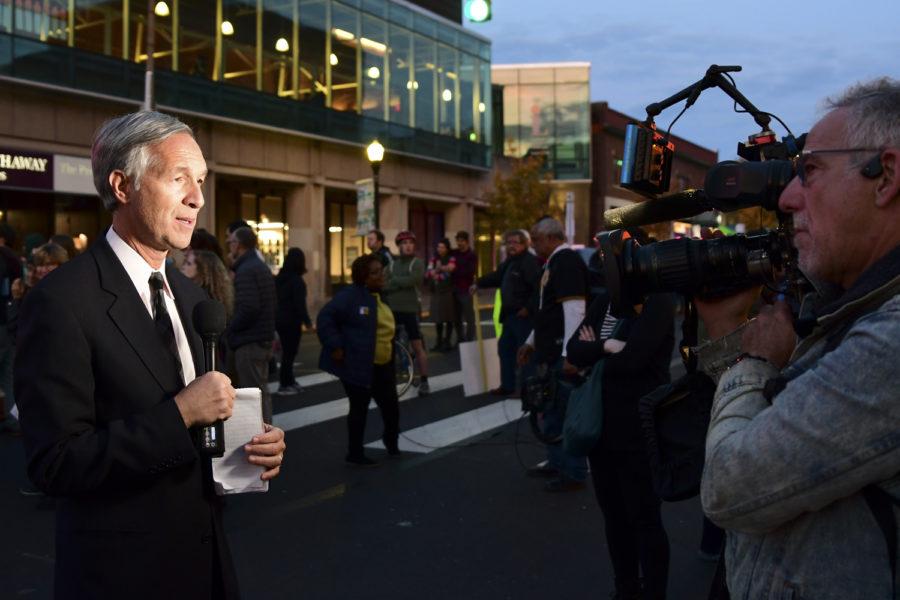How FBI, journalists prepared responses to violence
Bader Abdulmajeed | Staff Photographer
A broadcast journalist is filmed on the scene of a protest in opposition to President Donald Trump’s visit to Pittsburgh in the wake of the Tree of Life Synagogue shooting.
November 27, 2018
Within a minute of the call alerting the City that shots were fired in the Tree of Life Synagogue in Squirrel Hill on Oct. 27, police officers were on their way to the scene of the crime. Less than 10 minutes later, the Pittsburgh Public Safety Department tweeted out a message warning residents of an active shooter.
For first responders and news agencies, being prepared for mass acts of violence is necessary, especially since these acts are usually unpredictable. Each news agency maintains its own plans for how to respond and disseminate information about the acts, while law enforcement agencies focus on cooperation and prevention.
The FBI’s Pittsburgh field office is in charge of investigating crimes and assessing threats in West Virginia as well as much of Western Pennsylvania. Greg Nelsen, assistant special agent in charge of the Pittsburgh field office, said when it comes to threats of mass violence, the FBI has a large network of resources to deal with local, domestic and foreign threats.
“Upon receipt of a threat, the FBI immediately collaborates with appropriate local, state and federal law enforcement and intelligence agencies and establishes an investigative plan which is dependent on the nature of the threat,” Nelsen said. “The FBI relies upon various sources of information to identify homegrown violent extremists. These include human sources, reports from the public, federal, state and local law enforcement partners.”
The Pittsburgh Police relies on its specialty unit known as Rapid Emergency Deployment to respond to such incidents, including those suspected to be acts of terrorism or involving weapons of mass destruction.
Suzanne Nadell, the news director of WPXI-TV — an NBC-affiliated television station in Pittsburgh — said the channel keeps its newsroom staffed at all hours in case of breaking news.
“We work to make sure we are always ready to respond to breaking news. We understand we are 24/7 content providers. We always have newsroom staff in the newsroom and a plan to get on the air quickly,” Nadell said. “Reporters know it’s part of their job and they could have to do this at a moment’s notice.”
Preparation for breaking news isn’t limited to live broadcasting networks. Print newspapers and online content producers like the Pittsburgh Post-Gazette also prepare to react in a timely manner in case of a large news event. The Pittsburgh Post-Gazette’s assistant managing editor for local news, Lillian Thomas, said modern technology has enabled reporters to respond to events with mass fatalities much quicker than ever before.
“Even before I had started calling people, people were starting to move out towards the scene,” Thomas said. “People sort of self-report and then we have quick phone chain to let us connect with as many people as we need to get out in the field right away.”
Similarly, WPXI-TV’s reporters are also quick to respond to the scene of action before getting orders. Nadell accredits it to having reporters who understand their duties when a tragedy occurs.
“Part of it is planning, knowing that major news could happen at any time. Our journalists are also professionals who understand the duty that comes with their jobs. You don’t have to call people when tragedy strikes, they understand, they just show up,” Nadell said.
For some law enforcement officers, responding to incidents of mass violence can mean putting their own safety at risk. In the Tree of Life shooting, officers who went in to rescue wounded victims were shot at, resulting in four officers being hospitalized.
On the other hand, news agencies rely on their reporters staying safe so they can relay information that will in turn be distributed to the public. Nadell said the safety of all involved in the incidents is always kept in mind, including the safety of the first responders.
“Safety of our crews is our priority. We keep a safe distance and rely on eyewitness and reports from officials until we can get closer ourselves,” Nadell said.
According to Thomas, when on crime scenes, reporters must obey the perimeter established by the responding police officers. Outside of the barriers, reporters should use their own knowledge of the situation to assess risk.
“We ask our reporters to use common sense and not to do anything that makes them feel uncomfortable,” Thomas said.
Cooperation between news agencies and law enforcement can be beneficial for getting imperative information out for the public. During the Tree of Life shooting, local news agencies quickly reported that police were asking residents to stay inside of their homes until they apprehended the shooter.
In the following days, the City of Pittsburgh Public Safety put out a press release that praised the efforts of the local media for helping spread information deemed crucial for public safety.
“When we needed to deliver crucial information, you were there to serve the public. Everyone needed to work together as a city and community, and you served an essential role in that process,” the Oct. 29 press release said.
Immediately responding to and reporting on mass fatality incidents can be traumatic for some reporters, so news agencies like WPXI-TV make it a priority to openly discuss the sensitive nature of a topic while covering it.
“We discuss throughout all of our coverage how sensitive the topic is. We’ve found unless you make it a priority to have the discussion, it can get lost,” Nadell said. “So we talk about it, then talk about it some more and then talk about it again.”
The Pittsburgh Police could not be reached for comment.



